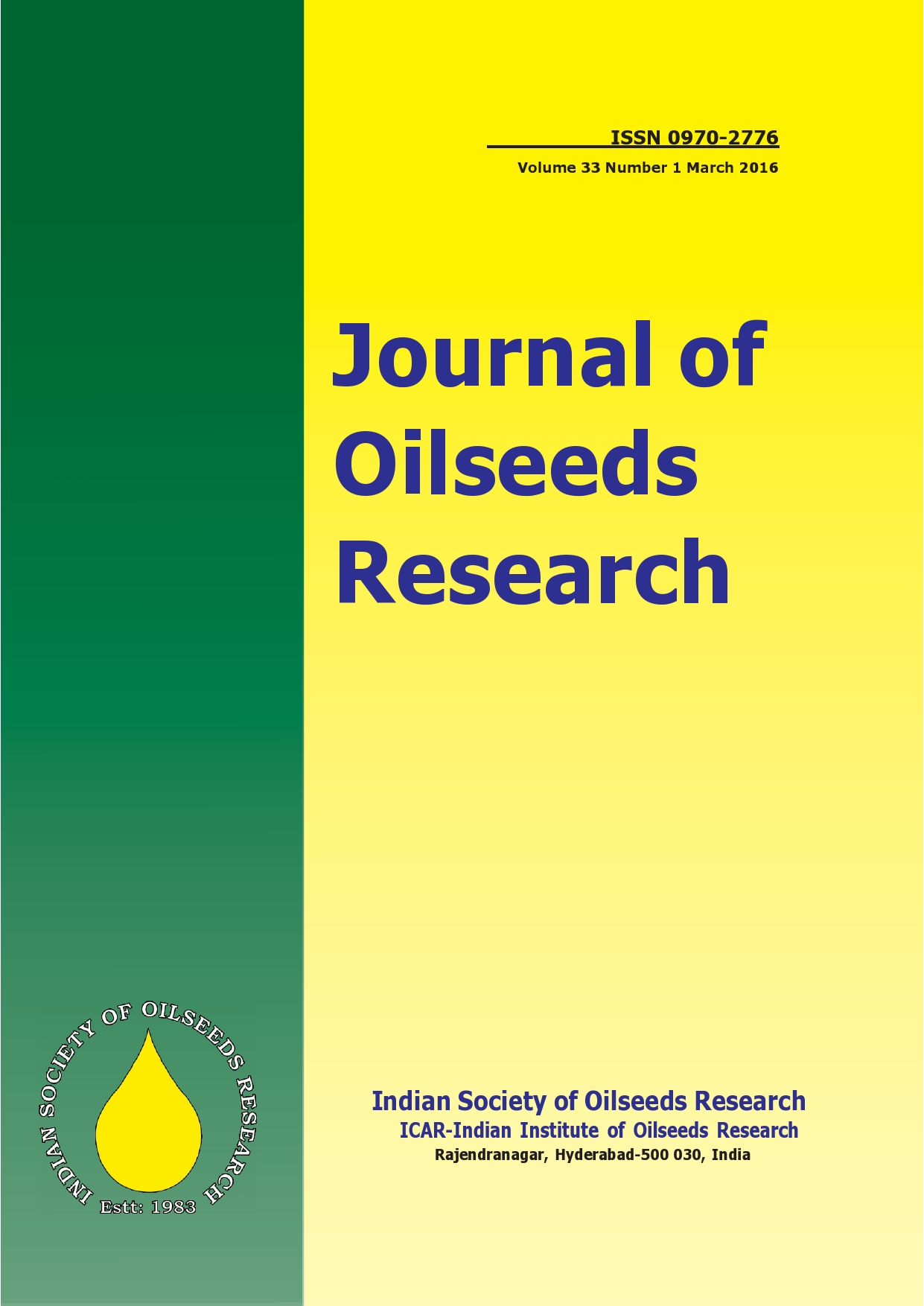Studies on integrated nutrient management on growth and productivity of Indian mustard (Brassica juncea) in high altitude range of Himalaya
STUDIES ON INM ON GROWTH AND PRODUCTIVITY OF INDIAN MUSTARD
84 / 0
Keywords:
Economics, Farm Yard Manure, Mustard, PhosphorousAbstract
Field investigations were carried out during the winter season of 2010-11 and 2011-12 at Lava (1850 m asl), under the aegis of Uttar Banga Krishi Viswavidayalaya, to evaluate the effect of different FYM and phosphorous levels on growth, yield and economics of Indian mustard [Brassica juncea (L.) Czern & Coss.] at high altitude. The field experiment consisted of four FYM levels (0, 10, 20 and 30 t/ha) in main plot and four phosphorous levels (0, 20, 40 and 60 kg P2O5 /ha) in subplot. Higher plant height and other growth parameters were registered with FYM @ 20t/ha, and was followed by FYM @10 t/ha. Amongst different levels of phosphorus, application of 60 kg P2O5 /ha registered significantly higher growth parameters and was at par with 40 kg/ha at 60 DAS and statically superior to other levels of P application. All the yield attributing characters were statistically influenced by different treatment combinations. Significantly higher seed yield was obtained with FYM @ 20t/ha (2.0 and 1.9 t/ha) and was statisticallyat par with FYM @ 10t/ha (1.8 and 1.9 t/ha) during 2010-11 and 2011-12, respectively. Amongst various subplot treatment highest seed yield during the first year was associated with the application of P2O5 @ 40 kg/ha (2.1 t/ha) and significantly better to other level of phosphorous. However during the second year higher seed yield was registered with 40 kg P2O5 /ha (1.9 t/ha), and was statistically similar with 60 kg P2O5/ha (1.8 t/ha) and 20 kg/ha (1.7 t/ha). Application of P2O5 @ 40 kg/ha resulted in 140.7% higher seed yield over no phosphorous application. Incorporation of FYM @ 20 t/ha registered 74.0% more stover yield compared to no FYM application. With various phosphorous doses, higher yield was registered with the application of 40 kg P2O5 /ha which was at par with 60 kg P2O5 /ha during both the year of experimentation. Application of FYM @ 20 t/ha gave maximum gross returns (` 19380/ha) and higher benefit: cost ratio (1.9). Higher benefit: cost ratio (1.90) was recorded with the application of P2O5 @ 60 kg/ha with net return of ` 18470/ha.
Downloads
References
Amanullah M A, Sekhar S and Muthukrishnan P 2010. Prospect and potential of chicken manure. Asian Journal of Plant Sciences, 34(1): 1-11.
Badsra S R and Chaudhary L 2001. Association of yield and its components in Indian mustard. Agriculture Science Digest, 21(2): 83-86.
Gajandand J, Sharma K K and Jat N K 2012. Effect of FYM and mineral nutrients on physico-chemical properties ofsoil under mustard in western arid zone ofIndia. Annals of Plant and Soil Research, 14(2): 167-166.
Ghosh S K and Gulati S C 2001. Genetic variability and association of yield component in Indian mustard (Brassica juncea L.). Crop Research, 21(3): 345-349.
Jackson M L 1973. Soil Chemical Analysis, Prentice Hall of India Pvt. Ltd., New Delhi.
Jat R S, Kanhangarot S S and Rathore S S 2000. Effect of different fertility levels on growth and yield ofmustard (Brassica juncea L. Czern and Coss). Annals of Agriculture Research, 21(3): 421-423.
Khajanchi Land Dravid M S 1990. Phosphate sulphate silicate and FYM interaction on P utilization by mustard. Journal of Nuclear Agriculture and Biology, 19(4): 232-235.
Kumar N 2006. Integrated nutrient management practices in mustard (Brassica juncea L.) and its effect on the productivity of succeeding rice crop. Ph.D. Thesis, Chaudhary Charan Singh University, Meerut.
Paroda R S 2013. The Indian oilseeds scenario: challenges and opportunities. Journal of Oilseeds Research, 30(2): 111-126.
Premi O P and Kumar M 2004. Response of Indian mustard (Brassica juncea L.) to different levels of nitrogen and phosphorus under irrigated condition. Indian Journal of Agriculture Research, 38(2): 151-153.
Rana K S, Rana D S and Gautam R C 2005. Influence of phosphorus, sulphur and boron on growth, yield and nutrient uptake and economics ofIndianmustard [Brassica juncea (L.)] under rainfed condition. Indian Journal of Agronomy, 50(4): 314-316.
Rao K T, Naidu G J and Subbaiah G 2006. Effect of foliar application of micronutrient on yield and yield attributes on Indian mustard (Brassica juncea L.). Agriculture Science Digest, 26(2): 144-146.
Singh M and Chauhan J S 2013. Genetic variation and correlations for some physiological characters and seed yield in Indian mustard (Brassica junceaL.) underrainfed conditions. Journal of Oilseeds Research, 30(2): 167-170.
Tripathi M K, Chaturvedi S, Shukla D K and Mahapatra B S. 2010. Yield performance and quality in Indian mustard [Brassica juncea (L.)] as affected by integrated nutrient management. Indian Journal of Agronomy, 55(2): 138-142.
Yadav R P, Tripathi M L and Trivedi S K 2010. Yield and quality of Indian mustard (Brassica juncea) as influenced by irrigation and nutrient levels. Indian Journal of Agronomy, 55(1): 56-59.
